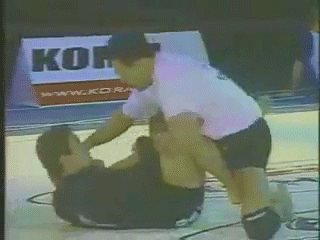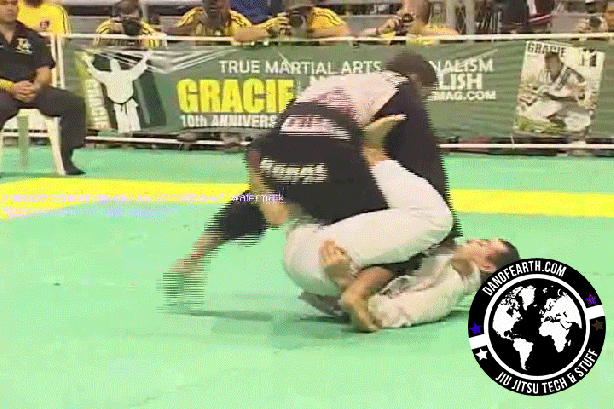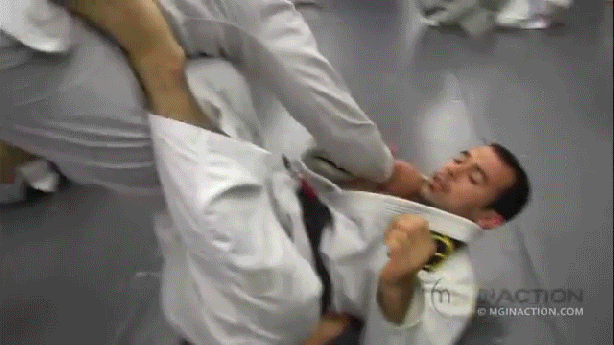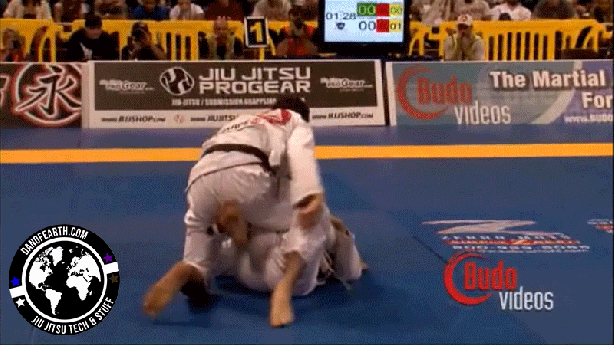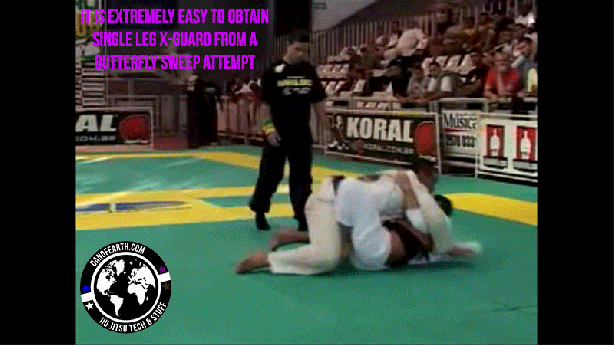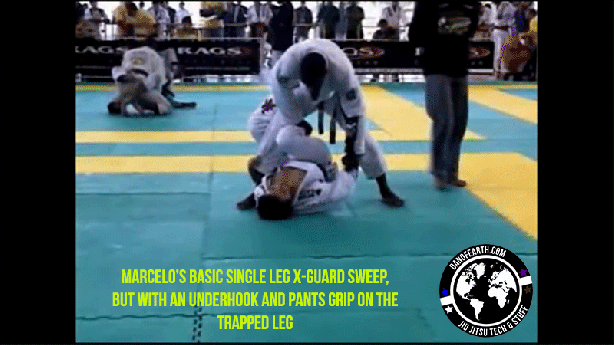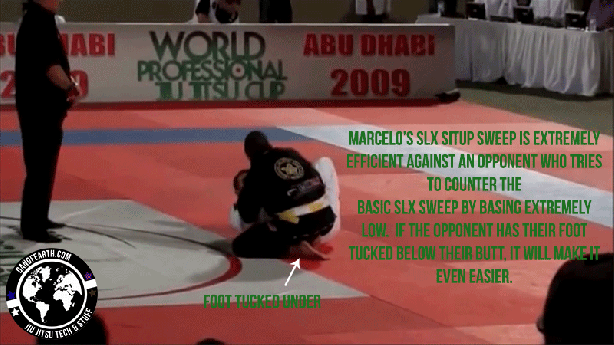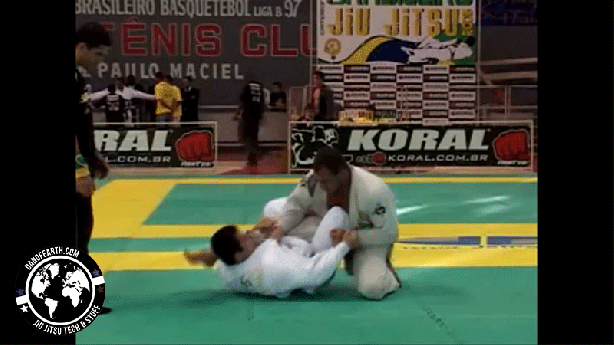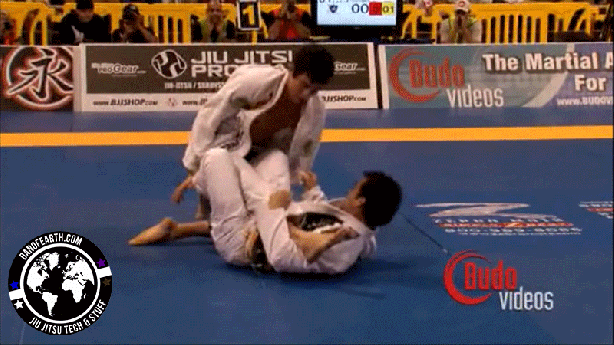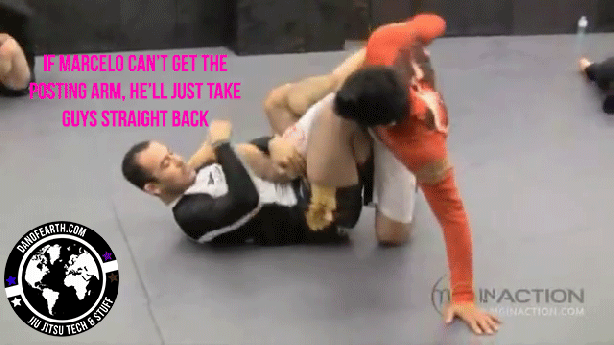Marcelo Garcia’s SLX to X-Guard Transitions, and a few X-Guard Sweeps to go with them.
So in my first breakdown of Marcelo Garcia’s Single Leg X-Guard (SLX) I covered some of his basic sweeps, grips, counters and leg positions when in the position. In this article though I’m going to cover when he switches out of it, or more importantly, the WHY. And because the reason he switches to X-Guard gives him a que for a specific set of sweeps, we’re going to cover those too.
We’ve already shown how dominant the position can be on it’s own, so he has to have some clear reasons on why he switches to Full X-Guard, from the SLX. So what are some the ques that let Marcelo know when to switch?
Firstly, Marcelo tends to go SLX > X-Guard, not so much X-Guard > SLX. He also usually starts in SLX to being with. I attribute this based on the fact that SLX is much easier to gain in the first place. He also usually starts with the overhook, I’d also attribute that to it being easier to get.
In our first GIF, (which is too small for text unfortunately) Marcelo is facing Renzo Gracie at the ADCC. Renzo attempts to counter Marcelo’s SLX by grabbing the back of his head with both hands, keeping his hips forward, low and keeping his opposite leg out of reach. By driving his hips forward, it makes it much more difficult for Marcelo to keep his outside leg on the hip, the position has become a very uncomfortable stack for Marcelo. Since Renzo has both hands free, he is able to base forward if Marcelo were to try and send him over the top by letting go of Marcelo’s head. Renzo is also keeping his base slightly to his left away from his trapped leg. From this position it would be very difficult for Marcelo to execute any of the SLX sweeps we showed previously, over-the-top or the basic sweep. So what Marcelo does with his outside leg is brings it inside for the X-guard position on Renzo’s opposite leg. He did this by keeping pressure on Renzo’s left leg with not only his hand but also his butterflied leg. This keeps his legs wider and easier to slip his outside foot in for the X-guard position. My favorite part of this sequence is when Marcelo then lifts Renzo up EVER so slightly using both his arms and his legs (by extending them upward) which causes Renzo to step in with his foot that had been generally pretty far away during this sequence. Marcelo catches the ankle with his right hand, gets his right leg butterfly hook high on Renzo’s thigh by lifting his hips (Marcelos foot is right below Renzo’s hamstring) and creates tension with his ankle grip. By pulling the ankle to him, driving forward with his right shin, and extending with his left leg Marcelo causes Renzo to fall backwards and Marcelo uses the momentum from the sweep to bring himself up and pulls his legs underneath of him to be able to come up for the sweep. Note that Marcelo during the entire sequence was blocking Renzo’s SLX’d leg either with an overhook or the inner part of his arm.
In our second GIF Marcelo pulls off any amazing sweep against Andre Galvao, but only after recognizing that he needed to make the switch to full X-guard from SLX. The video was kind of cruddy, so hopefully I can explain it well. Again, an opponent is stopping the SLX by pulling themselves into Marcelo, squatting low and trying to base out to the opposite side, keeping their leg out of reach. Andre keeps his leg behind him instead of up and to the side like in the GIF with Renzo, so Marcelo uses a different option. When Marcelo rocks himself up by extending his legs and then falls back bringing his legs in he is changing his “structure” or frame against his opponents body. Ryan Hall talks about this concept in his Inverted Guard DVD Series. It’s a great tool for manipulating momentum and changing your opponents position. You’ve provided a support to an opponent and kept the pressure on, and then when you want to remove that support, it unsettles your opponent. It’s an excellent tool from the bottom for sure.
Key differences in Andre’s defense compared to Renzo’s: Andre is farther back with his hips much lower to the ground than Renzo and keeps his leg much farther back when Marcelo moves to full X-guard, even going down to his knee on it. Andre’s free arm is really the only thing stopping Marcelo from sending him straight back. Marcelo takes Andre over his (Andre’s) right shoulder because he has no available posting opportunities at that angle.
Here is the same exact sweep, on a Rickson Gracie Black Belt (whom I believe is Brandon Hetzler?). Except this time he changes the angle to take his opponent to the side (almost over the top) of the underhooked leg based on the fact that his opponents base is weak to that side because he’s leaning towards it. He again has the “two birds” grip with the underhook on the leg and sleeve grip on the same side. You can get a much better view of his feet position and how he switches them to execute the sweep in this GIF. This Black Belts defense was something we’ve seen before, to pull into Marcelo, base to the opposite side and keep his leg back. It stopped the SLX no problem, but allowed Marcelo to easily transition to X-Guard. This opponent is a bit taller than his other two which can make getting the SLX difficult unless you’re whole body is virtually up in the air.
So when should you switch to X-Guard?
Well, Marcelo does it when guys are putting a lot of pressure into him (typically pulling on his head or collar), with their hips heavy into him, and when he can’t control their non-SLX sleeve. He does it when they are based off to the non-threatened side and keep their leg back. He does this regardless if he has an underhook or overhook.
Key Points:
- Marcelo likes to block the far side knee with both his hand and his butterfly hook to ensure he has enough space to get his other foot in X-Guard position from SLX.
- He will transition to X-guard even if he doesn’t have the underhook on the SLX’d leg.
- He applies pressure just so he can release the pressure later and take the available space in a different way. AKA changing your structure.
- He controls two limbs with just one limb, by underhooking the leg and grabbing the same side sleeve.
- With the X-guard Marcelo has sweeps available in a 360 direction around you, depending on what you throw at him.
- His transitions to X-guard from SLX are not spur of the moment decisions. They are part of a system that gives him signals when confronted with certain situations. He knows exactly what he’s looking for and knows exactly how to make his opponent give it to him.
- Body types definitely change up the SLX game. I know when I’m facing a really tall guy I really really have to get my hips off the ground. It seems Marcelo will only momentarily hang out in SLX against an opponent with a good base, throw a couple SLX sweep attempts, but then switch to X-Guard.
To learn from the man himself, check out MGinAction.com, Marcelo’s personal online training platform. He covers the SLX and X-Guard on his website and touches on a lot of these points, as well as a lot of points we haven’t discussed.
Notes:
One of the reasons I like doing breakdowns is because it really forces me to be a dedicated observer. These are just the distinct transitions and sweeps I observed in his highlight footage, there could very well be other ques and options involved, and knowing Marcelo, I’d find that highly likely. Anyone can do this by playing the same clips over and over. And the more people who are doing it the more observations people will make. I may not see what someone else sees, and we may see some of the same things, but not all. This is all part of breaking down the huge puzzle that is BJJ, but the more “eyes on” we get, the better off we’ll be. I cannot tell you how many times my BJJ game has taken gigantic leaps from someone pointing out something drastically obvious or on the other side of the coin pointing out something so small that it made the difference between being able to sweep blue belts to being able to sweep black belts. I’m not trying to cover “this is SLX guard” or “this is X-Guard”. I’m trying to point out things that correlate. Showing one sweep is fine and good, but seeing how it relates to your opponents ques is much better. Moves in BJJ do not exist in a vacuum nor in isolation, they are all a part of something much larger going on. It’s a chess battle with all the pieces moving at the same time. Having an answer for every defense, submission attempt and position is truly the ultimate goal, and although it will never happen, it doesn’t mean we can’t try.
 BJJ Scout
BJJ Scout Facebook
Facebook Grapplers Connection
Grapplers Connection OSS Clothing
OSS Clothing www.jiujitsuforums.com
www.jiujitsuforums.com


